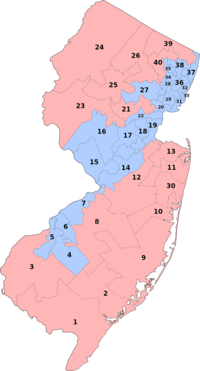New Jersey (U.S. state): Difference between revisions
Pat Palmer (talk | contribs) mNo edit summary |
Pat Palmer (talk | contribs) mNo edit summary |
||
| Line 21: | Line 21: | ||
Due to past industrial activity, New Jersey has had more [[Superfund]] toxic waste sites than any other state in the union--and this despite it's small geographic size. Fewer than a quarter of New Jersey’s Superfund sites--35 out of about 150 that have been on the EPA’s list at various times since the law was passed in 1980--have actually been cleaned up. | Due to past industrial activity, New Jersey has had more [[Superfund]] toxic waste sites than any other state in the union--and this despite it's small geographic size. Fewer than a quarter of New Jersey’s Superfund sites--35 out of about 150 that have been on the EPA’s list at various times since the law was passed in 1980--have actually been cleaned up. | ||
In 2022, the Sales Tax rate was 6.625% | In 2022, the Sales Tax rate was 6.625%<ref name=SalesTax />, and it is a "progressive" tax because items such as food, clothing, drugs, and manufacturing machinery are exempt. | ||
Residential land is scarce, and property taxes tend to be high relative to other parts of the United States. | Residential land is scarce, and property taxes tend to be high relative to other parts of the United States. | ||
| Line 35: | Line 35: | ||
<ref name=PopDens> | <ref name=PopDens> | ||
In 2020, the state had an average of 1,134.5 people per square mile. The sparsest state, [[Montana]], only has an average of just 6.86 people per square mile. | In 2020, the state had an average of 1,134.5 people per square mile. The sparsest state, [[Montana]], only has an average of just 6.86 people per square mile. | ||
</ref> | |||
<ref name=SalesTax> | |||
Certain specially designated Urban Enterprise Zones have their sales tax rate cut in half (in 2022, these zones existed in parts of Elizabeth, Bridgeton, Camden, Newark, Trenton, Plainfield, New Brunswick and Gloucester City). | |||
</ref> | </ref> | ||
</references> | </references> | ||
Revision as of 10:13, 19 March 2023
{{subpage
New Jersey is a small state in the northeast United States of America. It has the highest population density in the nation[1], and yet its state motto "The Garden State" reflects the presence of numerous farms and wooded lands, despite dense suburban sprawl in other areas. The state has two urban clusters, one in the center near New York City and another in the south near Philadelphia (that includes the state capital, Trenton).
Broadcast media in the state is typically sourced from either New York City or Philadelphia, and state-wide political campaigns must target both markets. The dense urban belt across the center of the state between the two city nexuses (i.e., the corridor running from New York to Philadelphia) tend to vote Democrat, whereas the more suburban and rural areas tend to vote Republican. The state has recently had governors from both parties. The two state senators have been Democrats in recent decades, and most (but not all) of the U.S. congressional representatives as well.
New Jersey's northern border with New York state is a straight line across land, but otherwise, New Jersey is surrounded by water on three sides:
- On the west, its border is the Delaware River, across from Pennsylvania.
- On the south, its border is the Delaware Bay, across from Delaware.
- On the southeast shoulder, its border is the Atlantic Ocean.
- On the northeast, its border is the Raritan Bay and the Hudson River, across from New York City.
New Jersey was one of the original thirteen states of the U.S.
As of 2022, all aspects of reproductive choice including abortion are protected by law.[2]
There are strict gun registration laws (no open carry).
Due to past industrial activity, New Jersey has had more Superfund toxic waste sites than any other state in the union--and this despite it's small geographic size. Fewer than a quarter of New Jersey’s Superfund sites--35 out of about 150 that have been on the EPA’s list at various times since the law was passed in 1980--have actually been cleaned up.
In 2022, the Sales Tax rate was 6.625%[3], and it is a "progressive" tax because items such as food, clothing, drugs, and manufacturing machinery are exempt.
Residential land is scarce, and property taxes tend to be high relative to other parts of the United States.
About a third of adults in the state identify as Catholic, another third as Christian, and the remaining third divided between various world religions on the one hand and agnostic/atheistic leanings on the other hand[4].
See also
References
- ↑ In 2020, the state had an average of 1,134.5 people per square mile. The sparsest state, Montana, only has an average of just 6.86 people per square mile.
- ↑ Text of the reproductive choice law passed by NJ in 2022, from the state of NJ website, last access 12/9/2022
- ↑ Certain specially designated Urban Enterprise Zones have their sales tax rate cut in half (in 2022, these zones existed in parts of Elizabeth, Bridgeton, Camden, Newark, Trenton, Plainfield, New Brunswick and Gloucester City).
- ↑ Religious Landscape of New Jersey since 2000, by Pew Research.

